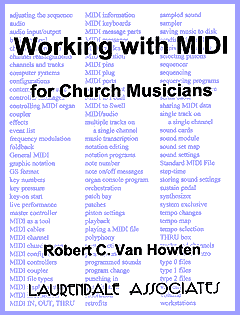

![]()

Working With MIDI
For Church Musicians

|
|
|
![]()
Table of Contents
![]()
| "MIDI" Stands for | 1 | |
| * | MIDI Allows Musicians To | 2 |
| * | MIDI Cables | 2 |
| * | MIDI Plugs | 3 |
| * | IN, OUT, and THRU | 3 |
| * | MIDI Ports | 4 |
| * | MIDI Channels | 4 |
| * | How MIDI Messages Travel | 5 |
| * | MIDI Modes | 6 |
| * | Computer Systems: Receiving, Processing/Storing and Sending Information | 6 |
| * | MIDI Interface | 7 |
| MIDI Messages | 8 | |
| * | The Sum of the Parts | 8 |
| * | MIDI Messages--a Series of Numbers--Not Sounds | 8 |
| * | A Single MIDI Message | 9 |
| * | How Fast Do MIDI Messages Travel? | 10 |
| * | From Music Score to MIDI Commands | 10 |
| * | Channel Voice Messages | 11 |
| * | Program Changes/Patches | 13 |
| * | MIDI Controller Messages | 13 |
| MIDI System Configurations | 15 | |
| * | MIDI Configuration No. 1 | 15 |
| * | MIDI Configuration No. 2 | 16 |
| * | MIDI Configuration No. 3 | 17 |
| * | Audio Concerns | 18 |
| * | MIDI Configuration No. 4 | 19 |
| MIDI Implementation Charts | 20 | |
| * | Reading a MIDI Implementation Chart | 21 |
| MIDI Keyboards | 24 | |
| * | MIDI Keyboards Are Used for | 24 |
| MIDI Church Organs | 26 | |
| * | Using the MIDI Organ To Control a Sound Module | 26 |
| * | Controlling a MIDI Sound Module from the MIDI Organ | 26 |
| * | Program Changes | 27 |
| * | Storing and Sending Program Changes (Standard Memory) | 27 |
| * | Controlling a MIDI Organ from a MIDI Keyboard | 28 |
| * | Saving and Restoring Combination Memories | 28 |
| * | Modifying Existing Organs for MIDI -- Retrofits | 28 |
| * | Assigning Channels | 29 |
| * | Limit of MIDI Sounds per Organ Manual | 30 |
| General MIDI | 31 | |
| * | How General MIDI Devices Differ | 34 |
| * | General MIDI Prerecorded Music Sequences | 36 |
| * | Comparing General MIDI Files with Prerecorded Music | 36 |
| * | Making Choral Study Tapes | 37 |
| Sound Modules | 38 | |
| * | Sound Module--"A synthesizer without a keyboard" | 38 |
| * | Storing the Sound Canvas's Settings to a Sequencer | 38 |
| * | Samplers | 39 |
| * | GS Standard | 39 |
| Sequencers | 40 | |
| * | Sequencer--"A computer without a monitor" | 40 |
| * | Playback | 41 |
| * | Punch-Ins | 41 |
| * | Applications | 41 |
| * | Program Playback | 41 |
| * | MIDI Patch Bay | 42 |
| Notation Programs | 45 | |
| * | Problems with MIDI and Notation Programs | 45 |
| * | Reproducing the Performance | 46 |
| * | Quantization | 46 |
| Sequencing Programs | 47 | |
| * | Saving Music to Disk | 48 |
| * | Types of MIDI Files | 48 |
| Copyright Law | 52 | |
| * | Copyright Act of 1976 | 52 |
| * | Copyright and Rehearsal/Public Performance Sequences | 53 |
| Choral Music in Sequence | 58 | |
| * | MIDI in Rehearsal | 59 |
| * | MIDI in Live Performance | 59 |
| * | MIDI and Contemporary Christian Music | 59 |
| * | Working with a Sequencing Program | 60 |
| * | Working with Choral Music Which Can Be Performed with Optional MIDI Resources | * 60 |
| * | Create a Sequence | 61 |
| * | MIDI Orchestration | 61 |
| * | Tracks and Channels | 62 |
| * | Selecting the Tempo | 64 |
| * | Adjusting Dynamics | 64 |
| * | Ongoing Adjustments | 64 |
| * | MIDI File Worksheet | 64 |
| * | "Humanizing" a Sequence | 67 |
| * | MIDI File Log | 68 |
| * | Anthem: "How Excellent Your Name, O Lord" | 69 |
| MIDI Files | 81 | |
| * | Open a MIDI File | 81 |
| * | Play a MIDI File/Sequence | 83 |
| * | Modify Program Changes/Patches | 85 |
| * | Save a File | 88 |
| * | Change the MIDI Channels | 90 |
| * | Set a Tempo Change | 92 |
| * | Change Smoothly from One Tempo to Another | 95 |
| Conclusions | 99 | |
| Appendix 1: Choral Music with Optional | * | |
| * | MIDI Support | 100 |
| Appendix 2: Books, Magazines & Videos | * | |
| * | About MIDI | 103 |
| * | Books | 103 |
| * | Magazines | 104 |
| * | Videos | 104 |
| Appendix 3: Sources of MIDI Files | 105 | |
| Appendix 4: Selected MIDI Products | 106 | |
| * | Allen MDS-Expander II | 106 |
| * | Gilbransen Digital Hymnal | 106 |
| * | MidiScan | 107 |
| * | Rodgers PR-300 | 107 |
| * | Roland/Rodgers W-50 | 107 |
| * | Roland Sound Canvas, SCP-55 | 108 |
| * | SynchroVoice MidiVox | 108 |
| * | Synthia | 108 |
| * | Coda Vivace--Personal Accompanist | 109 |
| Appendix 5: MIDI & Music Resources on the Internet | 110 | |
| * | Web Sites | 110 |
| * | Usenet Newsgroups | 111 |
| * | Electronic Mailing Lists | 112 |
| * | E-mail Addresses | 114 |
| Index | 115 | |
![]()
About The Author
![]()
Bob Van Howten earned his A.A. in music from Los Angeles Valley College, Van Nuys, California, B.A. in music, magna cum laude, and Standard Secondary Teaching Credential, Life, from UCLA, and his M.A. in music from California State University, Los Angeles.
Bob has taught music at all levels--from elementary and secondary (instrumental and choral) through college (music education and teacher training) and adult school (choral and orchestra) and was recently elected a member of ASCAP. He has directed church choirs and music programs for over 25 years and, as of this writing, is Director-Organist for adult and children's choirs at St. Mark Episcopal Parish, Van Nuys, Califomia.
Musically, Bob's primary area of interest involves the development of effective performance arrangements of classic choral works for choirs with limited musical resources. To this end, he has produced a series of arrangements of choral masterworks for small choirs that retain the characteristics of the original music, yet can be easily learned and performed. Additionally, he has created supplementary MIDI performance-accompaniment files to facilitate and enhance the presentation of each of these pieces.
In addition to his musical activities, Bob works in the rehabilitation of deaf persons who have received cochlear implants and serves as newsletter editor for the San Fernando Valley Chapter of the Choral Conductors Guild. His e-mail address is [email protected].
![]()
Laurendale Associates
15035 Wyandotte Street
Van Nuys, CA 91405-1746
voice: 818.994.6920
fax: 818.994.6958
If you encounter any problems using this site
please report them to:
[email protected]
This website including all contents, text, graphics, music and other associated media files are © 2002 by Laurendale Associates and may not be copied, duplicated or reproduced, in whole or in part, without the express written consent of Laurendale Associates. Audio clips, excepts, sample pages and all other materials herein are used with permission and are intended for promotional purposes only and are not licensed for direct consumer use. If you have any questions regarding licensing and usage of materials, including recording and performance rights, please contact Laurendale Associates at the address shown above.
